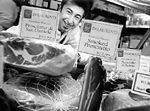Ah to be a pig in Parma, Italy—growing fat on whey from the region’s wonderful cheeses, wallowing in leisure, and finally ending your life immortalized in that ultimate porcine pleasure-product: prosciutto.
No matter what you do with prosciutto—wrap it around a cube of ripe cantaloupe or a fresh breadstick, cover it with cracked pepper, or use it to dress a chicken breast—its sweet, buttery, fragrant taste is unmistakable. Prosciutto is always sliced thin and is always priced for those with a fat wallet. You can find it in any good Italian grocery store or at supermarkets like Larry’s. It comes in a range (high to higher) of prices and from various locations. DeLaurenti’s, for instance, has American brands starting at approximately $10 per pound. But the Parma porkers, along with those from nearby San Daniele, DeLaurenti’s sells for nearly $20 a pound. Those prosciuttos, from the mountain towns of northern Italy, are considered the acme of this tenderly cured and well-aged ham.
Why? The answer is part romance, part tradition, and part ether.
Prosciutto might seem a peculiar object of passion to most of us, but to Fred Carlo, a sausage maker and, recently, meat consultant to the Admiral Thriftway in West Seattle, prosciutto is pork paradise. “It’s like fine red wine,” he sighs. “Prosciutto is the top of the line. It’s aged a lot longer than any other ham, and you can only make the best by doing it the old-fashioned way, like my grandparents would have.”
According to Carlo, prosciutto-making was part of the old-world culture transported to his childhood home in the hills of upstate New York. Houses were stocked with homemade wines, cheeses, tomato purees, canned fruits, and curing meats. “Cheech De Fabio—he was the local shoemaker, and he’d cure the hams for everyone,” Carlo says. “It was like there were little prosciutto laboratories all through the town—a lot of people had one or two hanging in the basement.”
Carlo left New York in his 20s, and the memories of prosciutto and its mysteries lay dormant in his mind for years. He moved to Portland in the mid-’80s and after his wife bought him a sausage-maker began making sausage for friends. Eventually, he decided to open up a wholesale sausage business, and he then sold sausage to a number of Portland restaurants.
On a four-month trip through Italy, though, he spent a few weeks with an Italian family in San Daniele. They were making prosciutto, and it piqued his interest.
Prosciutto is the purest of cured meat products. The challenge is to produce a cured ham with a minimum of preservatives. The finest prosciuttos use only two: first salt, and then cool, dry air. Both work to prevent the growth of bacteria. The hams are boned, then massaged and pounded with a wooden paddle to shape them, and finally brushed to give the skin a sheen. Then they are salted, but only as lightly as possible—prosciutto should be sweet, not salty. The ham is salt-cured for four to seven weeks, then washed and hung to let the mountain air work its magic. Basements in San Daniele and Parma are full of slowly curing hams. The whole process takes about 16 months, and the result is as far from run-of-the-mill ham as a Picasso is from a three-year-old’s scratchings.
When Carlo returned to Portland, he’d had a change of heart. “The sausage was great,” he recounts, “but I realized I really wanted to do prosciutto. The back room of [his Portland store] the Salumeria had good conditions for drying and curing. A friend of mine built racks to hold 150 hams, and I started making them using some local meat.”
As he had been taught, Carlo massaged and pressed the hams to shape them, salted them, and carefully monitored them during the first few months. “You smear a mixture of pepper and lard around the bone to keep insects out,” Carlo explains. “And at six months, you pierce the ham with a small, hollow bone from a horse leg. The horse bone will pick up the smell of the meat, and that’s how you check for spoilage. A good prosciutto is rose-colored, not too dark. It’s sweet, and the fat tastes pure, without any hint of rancidity.”
The hams hung for over a year in the cooler before they were ready. Carlo released 15 a month, and they made quite a stir. All Italian meat products had been banned in the United States after a disease scare in the mid-’50s, and good prosciutto was hard to find. He sold his aged hams to chefs up and down the West Coast—including luminaries like Barbara Figueroa and Alice Waters.
CARLO KEPT at it until three years ago. But with the lifting of the ban on imported prosciutto in 1990, he could taste how far he had to go. “They were good, but I just wasn’t satisfied,” he says. “I want more control over what goes into the pigs. You can make good prosciutto out of decent pork, but great prosciutto comes from great pigs.”
To create a great pig, you have to feed it great food. In Italy, prosciutto-bound pigs are fed a tightly controlled diet. Parma is known for its sweet grasses and fabulous cheeses—Parmigiano Reggiano, in particular—and Parma pigs spend most of their lives gorging on rich whey from the cheese-making factories. In the last month of their lives, the whey is discontinued. “The whey is great for giving the meat a smooth, fine taste. But the lactic acid in the whey would break down the proteins in the muscles after the pigs are slaughtered,” Carlo says. “So, for the last month, the pigs are fed acorns. I want to try and duplicate that whole diet with growers here.”
Carlo is going to spend the next year in Italy studying prosciutto. He’ll be peering into Parma basements crowded with hanging hams, chewing the fat—literally—with pig farmers and acorn purveyors, sniffing the mountain breezes that curl down the hills of San Daniele (he’s also curious about what sort of trace compounds might be in the mountain air used to dry the hams). Then he promises to return to the Northwest and share his knowledge with a few pig farmers, a few thousand pigs, and, eventually, those of us who enjoy this translucent and transcendent delicacy.
Whether Carlo will succeed in completely decoding the secrets of San Daniele remains to be seen. He does, however, have a backup strategy. “I’m not really sure what exactly is going to make these prosciuttos excellent—but I do plan to have a picture of the Pope hanging next to the hams.”









